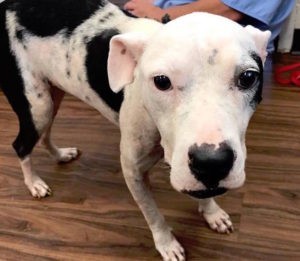Is your senior foster dog in pain?
I mean, how do you know, really? You may have just met him.
You don’t know this dog’s normal behaviors, health history, or what a normal day for this dog looks like. It just arrived to your home, for goodness sake.
You know when your personal senior dog is in pain.
It’s a bit more of a challenge when you have an unknown dog in your home that maybe is acting as if it is in pain. I can help you sort through some of the symptoms your senior foster dog might show and share ways you can help them feel better.
There’s no more helpless feeling in the world than feeling like you can’t help your senior foster that is in pain.
I am not a veterinarian nor an animal behaviorist. I present my understanding of health or behavior issues based on personal experience and research I’ve done. If you have a dog with a health or behavioral issue, seek professional guidance. I hope you find my post useful.
How I look At Pain
Pain can be:
- obvious vs subtle
- acute vs chronic
- mild vs severe
Sometimes I know the source of the pain (dog cuts paw pad and is limping) and sometimes I don’t. (dog standing in the middle of the room stiff and hunched over)
I’m not a veterinarian and unless I see an obvious issue I can fix with a little first-aid, I’m going to work with a veterinarian to understand why my senior foster dog is in pain and develop a plan to treat and/or manage the pain.
Pain Sources
I’ve had experience helping dogs cope with pain in all of the following conditions:
- injury/surgical procedures
- illness (such as cancers or infections)
- arthritis/orthopedic degenerations
What I’ve learned is that pain management is never a single method plan.
It takes a blend of modalities to help your dog heal quicker or cope better. Senior foster dogs can have a painful condition and have quality of life. Our job is to do what we can to recognize when our dog is in pain and do what we can to provide relief from that pain.
First Steps
I believe that every senior dog that arrives in a rescue agency needs a full senior wellness profile and annual exam. This includes:
- A full CBC/Chemistry with urinalysis, heartworm test, and a basic thyroid screen.
- A fecal exam that is sent out to an external lab. I also request giardia and coccidia testing if not included.
- a set of x-rays if the physical exam warrants.
- a dental cleaning with x-rays if warranted.
Yep. That’s expensive.
But that is what senior dogs require if we are providing good veterinary medicine for our rescued dogs. If you expect to adopt out a senior dog, you owe it to the adopter to know as much as is reasonable about the health of the dog. If you are caring for seniors as part of a senior/hospice program, you owe it to that dog to know as much as you can so that you can provide reasonable treatment and comfort care.
12 Ways To Know Your Senior Dog Is In Pain
1. A Change In Their Personality/Demeanor
Dogs that are in pain may become more irritable, grumpy, or they can become uncharacteristically aggressive. They may growl, snarl, get snippy, or out-and-out bite you. Usually, they do this in an attempt to get you to stop touching the spot that hurts.
ALWAYS take your dog to the vet when they first begin to behave out of character. That may be a challenge if this is a new senior foster dog, but you owe it to relieve that senior dog of pain.
Communicate any aggressive behavior to the veterinarian and rule out medical causes for this behavior.
Some ways that senior foster dogs in pain act different:
- Snapping at a hand that is putting a collar, harness, or leash on the dog. While this may be interpreted as a dog fearful of wearing gear, we’ve learned that sometimes it means pain in the neck that is amplified when there is pressure from leash tension.
- Ear infections are really, really painful. Sometimes, senior foster dogs may growl or nip fingers or bite when being petted or rubbed on/near the ears. Before you assume that the dog doesn’t like being touched there, have your veterinarian rule out an ear infection.

- Increased grumpiness during snuggle time on the sofa may indicate arthritis or soft tissue injury. Have your vet take a look if grumpiness is a new behavior in your dog. If you have a new senior foster dog, mention the behavior to your vet so they can investigate before you write off the behavior as a quirk.
- Petting your dog under the chin and they react? Rule out dental issues such as a broken tooth or abscess.
2. Dogs in pain will seem disinterested in their normal routine.
I remember the first few days of recovery after a particularly painful surgery on my foot. It involved removing part of a nerve leading to my toes. Nerve pain is awful.
If I tried to move to fix myself something to eat, it hurt. Reaching for a glass of water hurt. Walking for sure hurt.
So I did as little as I could so I wouldn’t elevate my pain. And I slept.
Dogs do the same thing. When they hurt, they change things to reduce their pain. They may not eat their whole meal. They may lie down to eat. They may stop bothering you thirty minutes before suppertime (in hopes you’ll feed them early!) because they hurt. They may drink less water. Play less. Walk slower. Sleep a whole lot more.
- monitor the quantity of food that is eaten every day
- monitor the amount of water that is consumed, best you can.
- pay attention to how much they sleep.
If you notice your senior foster dog isn’t following their normal routine, (if you know what their normal is) have your veterinarian check them out. There are so many ways to address pain in seniors dogs we owe it to them to have them evaluated for medical conditions that we can treat or make less painful.
3. Changes In Posture or Gait Are A Sure Sign Your Senior Dog Is In Pain
As I approach the age of 60, I’ve noticed a bit of stiffness in my feet, particularly when I first get up. My feet don’t want to “roll” as I walk, so I walk with a bit of a stomp until my toes wake up. No pain, really, but definitely a change in my morning gait. I have other evidence I’m nearly 60 years old, but I’ll spare you those details. Ha!
Dogs in pain will also change their posture, gait, or how they move about. Both of the dogs in my home are approaching their senior years and are showing signs of aging. Not only can I feel changes in the vertebrae of the spine, but I notice Otis holds his back end a little differently; he doesn’t walk as straight as he used to. We are soon scheduled for some x-rays to take a more in-depth look at his spinal health.
Sassy has already been diagnosed with spinal spondylosis.
*side note: If your senior foster dog is squinting one eye, they are more than likely in pain. There may be a foreign object in the eye or they may have a scratched cornea. Seek veterinary care.
4. Dogs In Pain Are Reluctant To Climb or Jump
You know the joke, “Doc, it hurts when I do this”, doc says, “Well, don’t do that.”
Dogs will avoid things that hurt, and make adaptations where they can.
I have a large deck, with two sets of steps. On the high side, I have a run of 5 steps. On the low side, I only have 2 steps. Even though it is further to walk to the low side to get onto the deck and to the back door, Both Otis and Sassy are avoiding the taller set of steps and going around to the shorter set of steps because it’s more comfortable for them.
You may notice your senior foster dog hesitates before jumping up on the bed or into the car. This may be pain related, and you may want to consider how you can adapt the environment to help them navigate without having to jump up or jar them selves jumping down.

5. Dogs In Pain May Have A Harder Time Posturing To Potty.
Dogs in pain may have difficulty posturing to potty, particularly when they need to defecate. This can lead to a dog failing to totally move the bowels or can even cause constipation if the dog decides the pain is something they want to avoid alltogether.
You may notice that when a male dog urinates, they stop hiking their leg so high, or they begin to posture like a female dog. A male dog isn’t necessarily being a lazy pee-er, they may hurt when they hike a leg! Likewise, a female dog may also fail to void their bladder all the way because it hurts to squat.
This can lead to increased urinary tract infections.
Senior Foster Dogs In Pain Don’t Play as Much
Is your dog’s toybox going undisturbed? Maybe your senior dog is turning down bully sticks or a yummy stuffed kong. If so, call your vet and schedule an appointment.
While some rescued dogs have never seen a toy in their life, others may be saying no to toys because of pain. It could be dental pain, but it could be an old injury to the jaw or any number of sources.
Before we assume that a dog is behaving a certain way because of past experiences (or lack thereof) we should always rule out painful medical conditions first.
7. Dogs in Pain May Act Stiff
Limping or stiffness is an obvious sign that a dog is not comfortable or is in pain from a condition or injury. Reasons for limping and stiffness vary so you’ll want to balance your assessments with veterinary input.
If you see your dog limping or acting stiff, give them a quick look-over. Look for cuts, scrapes, or other signs of injury. Using your hands, place light but firm pressure on the dog (careful if this is a new dog you do not know – avoid bites!) to see if you can localize tenderness. Follow up with your vet if you can’t determine the source of the pain. If your gut tells you to turn this into an emergency visit, you do that.
8. It Is Hard For A Senior Dog In Pain To Get Comfortable
Dogs who are experiencing discomfort may act restless or agitated. What does that look like? Well, your senior foster dog may pace the room, reposition themselves over and over, get up and move to a new spot, or seem like they just cannot settle down.
Sometimes we can track that behavior back to a medical procedure or treatment they are receiving, but if it’s out of the blue, call your vet. There may be a new medical condition emerging that needs care.
9. Changes in Breathing and Heart Rate Are A Clear Message To Evaluate Your Dog For Pain
Dogs in pain can have an increased respiratory rate, measured by how many breaths they take per minute. According to Blue Pearl Vet, dogs have a normal resting respiratory rate from the mid-teens to the mid-twenties. Respiratory rates above 35-40 breaths per minute is abnormal.
Here is how to take your dog’s respiratory rate:
Dogs pant for a variety of reasons, but if the panting is heavy, and you don’t have an obvious reason as to why, it can be serious and you should seek immediate veterinary care.
Dogs in pain can often have an elevated heart rate, measured by taking their pulse and counting the heartbeats per minute.
Small dogs have a higher heart rate than larger dogs. Here’s how to take your dog’s pulse:
10. Swelling Is Often Painful.
If you see an area on your senior foster dog that appears to be swollen, there likely is pain associated.
Recently, Otis woke from sleep and was favoring one front paw. On observation, I found a slight abrasion on his paw pad which didn’t totally explain his lameness. Upon closer inspection, I saw swelling in the area which let me know that the injury was more than just a tiny abrasion, and I reexamined the area. He had an oozing small wound.
11. Increased Vocalizations Are An Indication Your Dog Is In A Lot of Pain
Dogs that don’t feel well can whine, whimper, yelp, growl, or even howl.
Just like people, dogs can have different levels of tolerance to pain, so a dog that whimpers may not necessarily be in less pain than a dog that yelps or howls.
12. Trembling or Shaking
Dogs can tremble or shake when in pain. Sometimes it can be local to the source of the pain, or it can be a whole body response to pain. If your senior foster dog is trembling or shaking in pain, seek an eval with your veterinarian.
How To Help Your Dog Cope With Pain
1. Get An Accurate Diagnosis – Find The Source of Any Pain
The very first step in helping your dog cope with pain is to understand the source of the pain, and you often will need a veterinarian to help you with that.
When the source of the pain isn’t obvious, I usually end up being wrong when I try to decide why my dog is acting pained.
2. Use Good Nutrition
I think good nutrition is the foundation of good health.
- feed the best food you can afford. There are really good foods on the market that are affordable. Do your homework.
- keep your dogs at a healthy weight. Overweight dogs are more prone to injury and health issues, and overweight dogs have a tendency to have a more active inflammatory response, even when not in pain. Get that weight off!
- choose your dog’s snacks wisely and don’t over-treat. Even when you are training your dog to have better manners, you don’t need huge pieces of food for your rewards. Tiny pieces are just as strong a reward as a big chunk.
3. Talk With Your Veterinarian About Appropriate Supplements For Your Dog
- Your veterinarian has the most up to date information on the best supplements to provide your dog based on the conditions they have. Fish oils, glusosamine products, probiotics are some of the more popular supplements our dogs take, but there are others that may be helpful for your dog’s specific condition.
- Understand which supplements can be taken long-term and which ones need to be taken in shorter intervals with breaks in between. This is particularly true if you are working with an herbalist.
4. Provide Support to Avoid Over-Exertion
- If your vet orders rest, help your dog rest. This may mean using a crate or exercise pen or baby gates to limit access to the whole house.
- leash walk up and down stairs. If your dog is small, carry them.
- provide easy access to furniture. Ramps are great for this.
- ditto for rides in the car. Help them into and out of the car or use a car ramp.
5. Use Pain Medications As Prescribed
If you walk away from one nugget of information from this blog post, let it be this one:
Pain is easier to manage when it isn’t allowed to get too elevated. You may want to tough it out with your pain, but don’t ask your dog to.
Understand the particular pain medication prescribed for your dog and why it is prescribed. Some pain medications are short-term use and others can be used for more chronic conditions. Make sure you know the side effects and if there is any monitoring that needs to be done such as blood work.
Give medications on time, every time, and if you think the dosage is not controlling your dog’s pain, call your veterinarian and discuss your observations.
6. Manage The Environment to Help Cushion Your Dog’s Pain
- keep activity and excitability to a minimum. Put a sign on your front door telling guests how to announce their presence without ringing the doorbell. Use crates, baby gates, and exercise pens.
- put down rugs if you have hard floors. Slipping and sliding when you are in pain isn’t fun.
- If appropriate, adjust the height of water and food bowls.
- Change bedding from soft plushy beds to orthopedic beds.
7. Use Appropriate Exercise – The Right Amount Can Help Ease Pain
Ask your veterinarian about the best exercises to help your dog. There may be a time when your dog shouldn’t exercise at all, but often, a dog will be allowed to return to activity and you want to know the best way. Low impact exercise is always good and swimming can be excellent if you have access to a temperature controlled pool.
8. Compresses, Massage, Chiropractic, and Acupuncture – Excellent Treatments For Dogs In Pain
Compresses, laser therapy, massage, chiropractic, and acupunture therapies are all wonderful pain management tools. Talk with your veterinarian about the appropriateness of any of these therapies for your dog’s particular needs. I’ve seen acupuncture help avoid surgery, laser therapy shorten healing time from invasive surgeries, and chiropractic adjustments stop a dog from grinding his spine into the ground, it hurt so bad. It’s wonderful when you can provide your dog with a non-medicine, non-invasive treatment plan or treatment support.
Summary
I hope that by outlining these points, I have helped you identify some new ways you can “listen” to your senior foster dog and determine if or when they are exhibiting pain. None of us want our dogs to hurt; we want to know when they are hurting, and we want to know what we can do to alleviate that pain. We want our senior foster dogs to have the best quality of life for as long as possible.
Thank you for fostering the senior dogs.

Popular Posts
How To Foster Dogs – 10 Skills You Need To Know
How To Choose A Dog Rescue Agency
Let Your Foster Dog Go – Tips For Adoption





